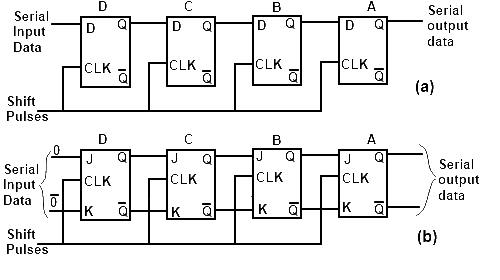Applications of Flip Flops
Flip flops are used in digital electronics some of its main applications are described below.
Data Storage
A flip flop store one bit at a time in digital circuit. In order to store more than one bit flip flop can be connected in series and parallel called registers. A register is simply a data storage device for a number of bits in which each flip flop store one bit of information (0 or 1). Thus a 4 bit register consists of 4 individual flip flops, each able to store one bit of information at a time.

Figure 1 shows a 4 bit register. Any number from (0000)2 to (1111)2 may be stored in it simply by setting or resetting the appropriate flip flops. Let us suppose that flip flop one is SET(1) , Flip flop 2 is RESET(0), flip flop 3 is RESET(0) and flip flop 4 is SET(1), the binary number stored in this register is (1001)2.
Data Transfer
Flip flops can also be used extensively to transfer the data. For this purpose shift register is used. A shift register is a register which is able to shift or transfer it content within itself without changing the order of the bits. It may be designed to shift or transfer data either left or right. The data is shifted or transferred one bit at a time, when a clock pulse is applied. The shift register can be used for temporary storage of data. The shift register is used for multiplication and division where bit shifting is required. The shift register can be built using RS, JK or D flip flops.
A four stage shift right register is shown in Figure 2. Input data is applied to store D and shifted right.

Each flip flop is controlled by the output Figure 2: Shift Right Registerof the proceeding flip flop. Clock signal is applied simultaneously to all flip flops. With each clock pulse information is transferred to next flip flop as shown below.
| D | C | B | A |
|---|---|---|---|
| 0 | 0 | 0 | 0 |
1011 After 1st Clock
| 1 | 0 | 0 | 0 |
| 1 | 1 | 0 | 0 |
| 0 | 1 | 1 | 0 |
| 1 | 0 | 1 | 1 |
In the above four bit shift right the information from input could be transferred to output in four clock pulses. This is an example of data transfer.
Counter
Another major application of flip flops is a digital counter. It is used to count pulses or events and it can be made by connecting a series of flip flops. Counter can count up to 2n. Where n is the number of flip flops. Figure 3 shows a simplest binary ripple counter made by flip flops. It consists of connections of flip flop without any logic gate. Each flip flop is triggered by the output of its proceeding flip flop.

They are used in digital equipments, clocks, frequency counters and computers etc.
Frequency Division
Flip flops can divide the frequency of periodic waveform. When a pulse wave is used to toggle an flip flop, the output frequency becomes one half the input frequency, as shown in Figure 4

The output of each flip flop is half the frequency of an input. If the input frequency is 160 KHz then output of each flip flop would be so after first flip flop, 40 after second flip flop and 20 after third flip flop.
Input frequency 160 KHz
Frequency of first flip flop 80 KHz
Frequency of 2nd flips flop 40 KHz
Frequency of 3rd flips flop 20 KHz
